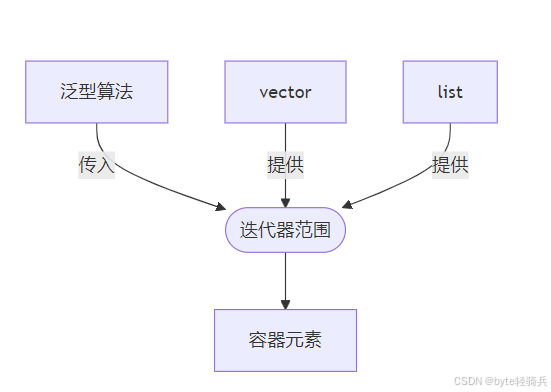目录
在 C++ 编程中,算法是处理数据的核心工具。传统算法往往针对特定数据类型设计,缺乏复用性;而泛型算法(Generic Algorithms)通过模板技术实现类型无关化,可适配多种容器与数据类型,极大提升代码通用性与效率。
一、泛型算法基础概念
1.1 什么是泛型算法?
泛型算法是一类基于模板的通用函数,不依赖具体数据类型,而是通过迭代器(Iterator)操作容器元素。例如,std::find用于查找元素,既可作用于vector
-
类型无关性:可作用于各种容器类型
-
通用接口:统一使用迭代器作为访问接口
-
高效实现:经过深度优化的经典算法实现
-
可组合性:算法之间可灵活组合使用
1.2 核心设计原则
- 类型无关性:通过模板参数推导数据类型(如T)。
- 迭代器抽象:算法仅依赖迭代器接口(如*it取值、++it移动),不关心容器内部结构。
- 复用性:一套算法适配多种容器(vector、list、deque等)。
1.3 算法分类体系
STL算法可分为六大类:
| 分类 | 代表算法 | 特性说明 |
|---|---|---|
| 非修改序列算法 | find, count, for_each | 不改变容器内容 |
| 修改序列算法 | copy, replace, reverse | 直接修改容器元素 |
| 排序相关算法 | sort, stable_sort | 元素排序和重组 |
| 数值算法 | accumulate, inner_product | 数学计算操作 |
| 集合算法 | set_union, set_difference | 集合运算 |
| 堆算法 | make_heap, push_heap | 堆结构操作 |
1.4 与 STL 容器的关系
泛型算法是 C++ 标准模板库(STL)的重要组成部分,与容器紧密协作:
- 容器提供数据存储:如vector管理动态数组。
- 算法提供操作逻辑:如std::sort对容器元素排序。
- 迭代器架起桥梁:通过迭代器范围[first, last)指定算法作用区间(last指向末尾后一位)。
图示:泛型算法、容器与迭代器的协作关系

二、迭代器:泛型算法的 “钥匙”
2.1 迭代器类型
C++ 定义了 5 类迭代器,算法依需求选用:
| 类型 | 功能特性 | 典型应用算法 |
| 输入迭代器 | 单向读取(*it、++it) | std::find、std::for_each |
| 输出迭代器 | 单向写入(*it = value) | std::copy |
| 前向迭代器 | 单向读写(输入 + 输出功能结合) | std::list专用算法 |
| 双向迭代器 | 双向读写(--it支持逆向) | std::reverse |
| 随机访问迭代器 | 随机定位(it[n]、it += n) | std::sort、std::binary_search |
2.2 迭代器适配器
- std::back_inserter:自动适配push_back,简化元素插入。
- std::istream_iterator/std::ostream_iterator:绑定流对象,实现文件 / 控制台数据读写。
示例:使用std::back_inserter向vector插入元素
- #include
- #include
- #include
- using namespace std;
-
- int main() {
- vector<int> v;
- auto inserter = back_inserter(v); // 创建插入迭代器
- *inserter = 10; // 等效于v.push_back(10)
- *inserter = 20;
- for (int x : v) cout << x << " "; // 输出: 10 20
- return 0;
- }

三、常用泛型算法分类与实战
3.1 非修改型算法(只读)
- 查找类:std::find、std::count
- 判断类:std::all_of、std::any_of
- 统计类:std::accumulate
示例:统计容器中偶数个数
- #include
- #include
- #include
- using namespace std;
-
- void doubleValue(int& x) { x *= 2; }
-
- int main() {
- vector<int> v = {1, 2, 3};
- std::for_each(v.begin(), v.end(), doubleValue);
- for (int x : v) cout << x << " "; // 输出: 2 4 6
- return 0;
- }

3.2 修改型算法
- 变换类:std::transform
- 替换类:std::replace
- 删除类:std::remove(需结合容器erase真正删除)
示例:将容器元素翻倍
- #include
- #include
- #include
- using namespace std;
-
- void doubleValue(int& x) { x *= 2; }
-
- int main() {
- vector<int> v = {1, 2, 3};
- std::for_each(v.begin(), v.end(), doubleValue);
- for (int x : v) cout << x << " "; // 输出: 2 4 6
- return 0;
- }

3.3 排序与搜索算法
- 排序:std::sort(快速排序)、std::stable_sort(稳定排序)
- 二分查找:std::binary_search
示例:自定义比较函数排序结构体
- #include
- #include
- #include
- using namespace std;
-
- struct Point {
- int x, y;
- };
-
- bool compareByX(const Point& a, const Point& b) {
- return a.x < b.x;
- }
-
- int main() {
- vector
points = {{3, 4}, {1, 2}, {2, 3}}; - std::sort(points.begin(), points.end(), compareByX);
- for (const auto& p : points) {
- cout << "(" << p.x << ", " << p.y << ") ";
- }
- return 0;
- }

四、算法的高阶应用与优化
4.1 自定义谓词(Predicate)
通过 lambda 表达式或函数对象定制算法逻辑,如std::sort的比较规则、std::find_if的查找条件。
4.2 性能优化技巧
- 避免不必要的拷贝:使用std::move减少元素复制开销。
- 选择合适的容器与算法:例如,std::list不适合std::sort(需随机访问迭代器),应改用std::list::sort。
4.3 C++20 新特性:Ranges 库
Ranges 库简化算法调用,支持惰性求值(延迟计算)。例如:
- #include
- #include
- #include
- using namespace std;
-
- int main() {
- vector<int> v = {1, 2, 3, 4, 5};
- auto result = v | views::filter([](int x) { return x % 2 == 0; }) | views::transform([](int x) { return x * 2; });
- for (int x : result) cout << x << " "; // 输出: 4 8
- return 0;
- }
五、典型应用场景
5.1 数据处理流水线
- // 读取数据 -> 过滤 -> 变换 -> 统计 -> 输出
- ifstream input("data.txt");
- vector raw_data;
-
- // 读取阶段
- Data temp;
- while (input >> temp) {
- raw_data.push_back(temp);
- }
-
- // 过滤阶段
- auto new_end = std::remove_if(raw_data.begin(), raw_data.end(),
- [](const Data& d){ return d.value < 0; });
- raw_data.erase(new_end, raw_data.end());
-
- // 变换阶段
- std::transform(raw_data.begin(), raw_data.end(), raw_data.begin(),
- [](Data d){ d.value *= 2; return d; });
-
- // 统计阶段
- int count = std::count_if(raw_data.begin(), raw_data.end(),
- [](const Data& d){ return d.category == "A"; });
-
- // 输出阶段
- std::for_each(raw_data.begin(), raw_data.end(),
- [](const Data& d){ cout << d << endl; });
5.2 游戏对象管理
- class GameObject {
- public:
- bool isActive() const { return m_active; }
- void update() { /* ... */ }
- private:
- bool m_active = true;
- };
-
- vector
objects; -
- // 批量更新活跃对象
- std::for_each(objects.begin(), objects.end(),
- [](GameObject& obj){ if (obj.isActive()) obj.update(); });
-
- // 移除所有非活跃对象
- auto new_end = std::remove_if(objects.begin(), objects.end(),
- [](const GameObject& obj){ return !obj.isActive(); });
- objects.erase(new_end, objects.end());
5.3 GUI事件处理
- vector
event_queue; -
- // 处理鼠标事件
- auto it = std::remove_if(event_queue.begin(), event_queue.end(),
- [](const Event& e){
- return e.type != MOUSE_MOVE &&
- e.type != MOUSE_CLICK;
- });
- event_queue.erase(it, event_queue.end());
-
- // 分派事件
- std::for_each(event_queue.begin(), event_queue.end(),
- [](const Event& e){
- switch(e.type) {
- case MOUSE_MOVE: handle_move(e); break;
- case MOUSE_CLICK: handle_click(e); break;
- }
- });
六、 常见误区与解决方案
6.1 迭代器失效问题
- 场景:容器插入 / 删除元素后,原有迭代器可能失效。
- 解决:使用插入迭代器(如back_inserter)或及时更新迭代器。
6.2 算法与容器不匹配
例如:对list使用std::sort会编译错误,应改用list::sort。
误用std::remove
- vector<int> v = {1, 2, 2, 3};
- v.erase(std::remove(v.begin(), v.end(), 2), v.end()); // 移除所有值为2的元素
std::remove仅逻辑删除(移动元素),需配合erase真正释放空间:
七、总结
泛型算法通过模板与迭代器的结合,实现了高度抽象与复用,是 C++ 高效编程的基石。从基础查找排序到复杂自定义逻辑,掌握算法的使用场景与迭代器适配技巧,能大幅提升代码质量。结合 C++ 新特性(如 Ranges 库),更可进一步简化开发流程。后续可深入探索分区算法、堆操作等进阶内容,解锁更多编程可能。
八、参考资料
- 《C++ Primer(第 5 版)》这本书是 C++ 领域的经典之作,对 C++ 的基础语法和高级特性都有深入讲解。
- 《Effective C++(第 3 版)》书中包含了很多 C++ 编程的实用建议和最佳实践。
- 《C++ Templates: The Complete Guide(第 2 版)》该书聚焦于 C++ 模板编程,而
using声明在模板编程中有着重要应用,如定义模板类型别名等。 - C++ 官方标准文档:C++ 标准文档是最权威的参考资料,可以查阅最新的 C++ 标准(如 C++11、C++14、C++17、C++20 等)文档。例如,ISO/IEC 14882:2020 是 C++20 标准的文档,可从相关渠道获取其详细内容。
